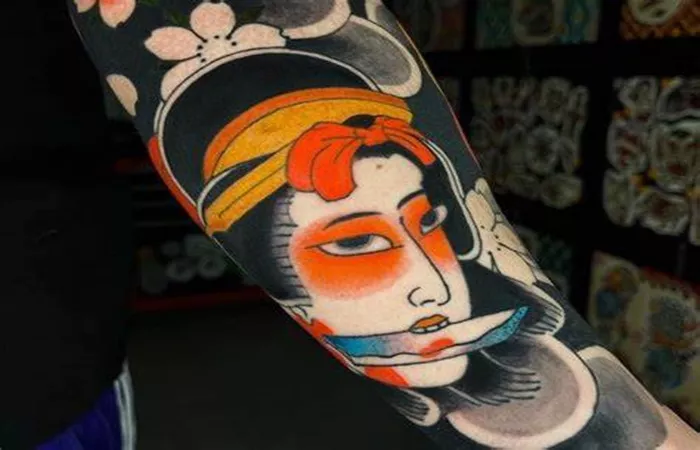Japanese tattoos, known as irezumi, are not mere body art but living chronicles of history, mythology, and cultural identity. Unlike their Western counterparts that often prioritize aesthetics, Japanese tattoos serve as visual narratives steeped in centuries of tradition. This article delves into the symbolic language embedded within irezumi, exploring how each design choice carries profound meaning.
The Historical Tapestry of irezumi
Origins in Ancient Rituals
The roots of irezumi trace back to prehistoric Japan, where indigenous tribes used tattoos for spiritual protection. Early designs, often geometric patterns and animal motifs, were believed to ward off evil spirits and bestow strength upon the wearer. These primitive tattoos were not merely decorative; they were integral to shamanic practices, signifying a connection to the spiritual realm.
Social Stigma and Cultural Shifts
During the Edo period (1603 – 1868), irezumi underwent a significant transformation. Initially adopted by firefighters and laborers as a form of camaraderie, tattoos became associated with the yakuza—Japan’s organized crime syndicate. The government, aiming to maintain social order, imposed strict laws against visible tattoos, turning irezumi into a symbol of rebellion and marginalization. This stigma persists today, with many public baths and swimming pools still banning tattooed individuals.
Symbolic Elements in Japanese Tattoos
Mythical Creatures: Guardians of the Spirit
Dragons: Revered as the most powerful symbol in irezumi, dragons represent strength, wisdom, and good fortune. In Japanese mythology, dragons control the rain and the seas, making them both feared and respected. A dragon tattoo often depicts the creature coiled around the body, its sinuous form symbolizing the ebb and flow of life.
Koi Fish: Symbolizing perseverance and transformation, koi fish tattoos are deeply rooted in Japanese folklore. The story of a koi swimming upstream against the current to reach the Dragon’s Gate, where it transforms into a dragon, embodies the human spirit’s ability to overcome adversity.
Tigers: Representing courage and ferocity, tigers are often depicted in battle scenes or with flames licking at their fur. Unlike Western interpretations of tigers as solitary hunters, Japanese tattoos portray them as protectors, warding off evil and ensuring safety.
Floral Motifs: Ephemeral Beauty
Cherry Blossoms (Sakura): A universal symbol of transience, cherry blossoms remind wearers of life’s impermanence. Their brief blooming period, often associated with the samurai’s acceptance of death, adds a layer of philosophical depth to the tattoo.
Peonies (Botan): Symbolizing prosperity, honor, and good fortune, peonies are one of the most elaborate designs in irezumi. Their large, vibrant petals represent nobility and wealth, making them a popular choice for those seeking auspicious meanings.
Chrysanthemums (Kiku): Adopted as the imperial flower of Japan, chrysanthemums signify longevity, rejuvenation, and loyalty. Their 16-petal form, known as the chrysanthemum seal, is a sacred symbol closely associated with the imperial family.
Traditional Patterns: Woven Tales
Wave Patterns (Ondo): Inspired by Hokusai’s iconic The Great Wave off Kanagawa, wave tattoos represent the power and unpredictability of nature. The undulating lines can also symbolize the wearer’s emotional journey or the passage of time.
Cloud Patterns (Kumo): Often used as background elements, clouds add depth and movement to tattoos. They symbolize the heavens, spirituality, and the ever-changing nature of life.
Geometric Patterns (Mons): Derived from family crests and traditional textiles, geometric patterns carry personal significance. Each design, whether it’s a simple circle or a complex interlocking motif, represents the wearer’s heritage or personal values.
The Artistic Process Behind irezumi
The Mastery of Horimono
Traditional irezumi is created using the horimono technique, a painstaking process involving hand-poking needles. This method allows artists to control the depth and density of the ink, resulting in intricate designs that blend seamlessly with the body’s contours. The use of natural dyes, such as indigo and sumi ink, further enhances the tattoo’s authenticity.
The Role of the Horishi
Horishi, or tattoo artists, are revered as master craftsmen in Japanese culture. Apprenticeships can last up to ten years, during which time aspiring artists study traditional techniques, mythology, and the cultural significance of each design. A skilled horishi not only creates beautiful tattoos but also guides clients in choosing designs that resonate with their personal stories.
Personal Significance and Cultural Identity
Tattoos as Self-Expression
In modern Japan, irezumi has evolved beyond its historical associations. Many individuals choose to get tattoos as a form of self-expression, using traditional designs to convey personal values, life experiences, or cultural heritage. A tattoo can serve as a permanent reminder of a significant event, a loved one, or a philosophical belief.
Cultural Preservation Through Ink
Despite the social stigma, irezumi continues to thrive as a form of cultural preservation. Younger generations are reclaiming traditional designs, adapting them to contemporary aesthetics while maintaining their symbolic integrity. This revival not only honors Japan’s rich tattoo heritage but also challenges societal perceptions about body art.
Conclusion
Japanese tattoos are a complex tapestry of history, mythology, and personal meaning. Each design, whether it’s a mythical creature, a floral motif, or a traditional pattern, tells a story that transcends time and culture. By understanding the symbolism behind irezumi, we gain a deeper appreciation for the art form and the cultural values it represents. As irezumi continues to evolve in the modern world, its timeless symbols will undoubtedly continue to inspire and captivate generations to come.
Related topics

